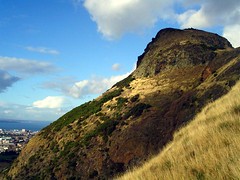Arthur's Seat is the main peak of the group of hills which form most of Holyrood Park, a remarkably wild piece of highland landscape in the centre of the city of Edinburgh, about a mile to the east of Edinburgh Castle. The hill rises above the city to a height of 251 m (823 feet), provides excellent panoramic views of the city, is quite easy to climb, and is a popular walk. Though it can be climbed from almost any direction, the easiest and simplest ascent is from the East, where a grassy slope rises above Dunsapie Loch.
Like the castle rock on which Edinburgh Castle is built, it was formed by an extinct volcano system of Carboniferous/Mississippian age (approximately 350 million years old), which was eroded by a glacier moving from west to east during the Quaternary, exposing rocky crags to the west and leaving a tail of material swept to the east [1]. This is how the Salisbury Crags formed and became basalt cliffs between Arthur's Seat and the city centre. From some angles, Arthur's Seat resembles a sleeping lion.
See the whole article here
Subscribe to:
Post Comments (Atom)


No comments:
Post a Comment